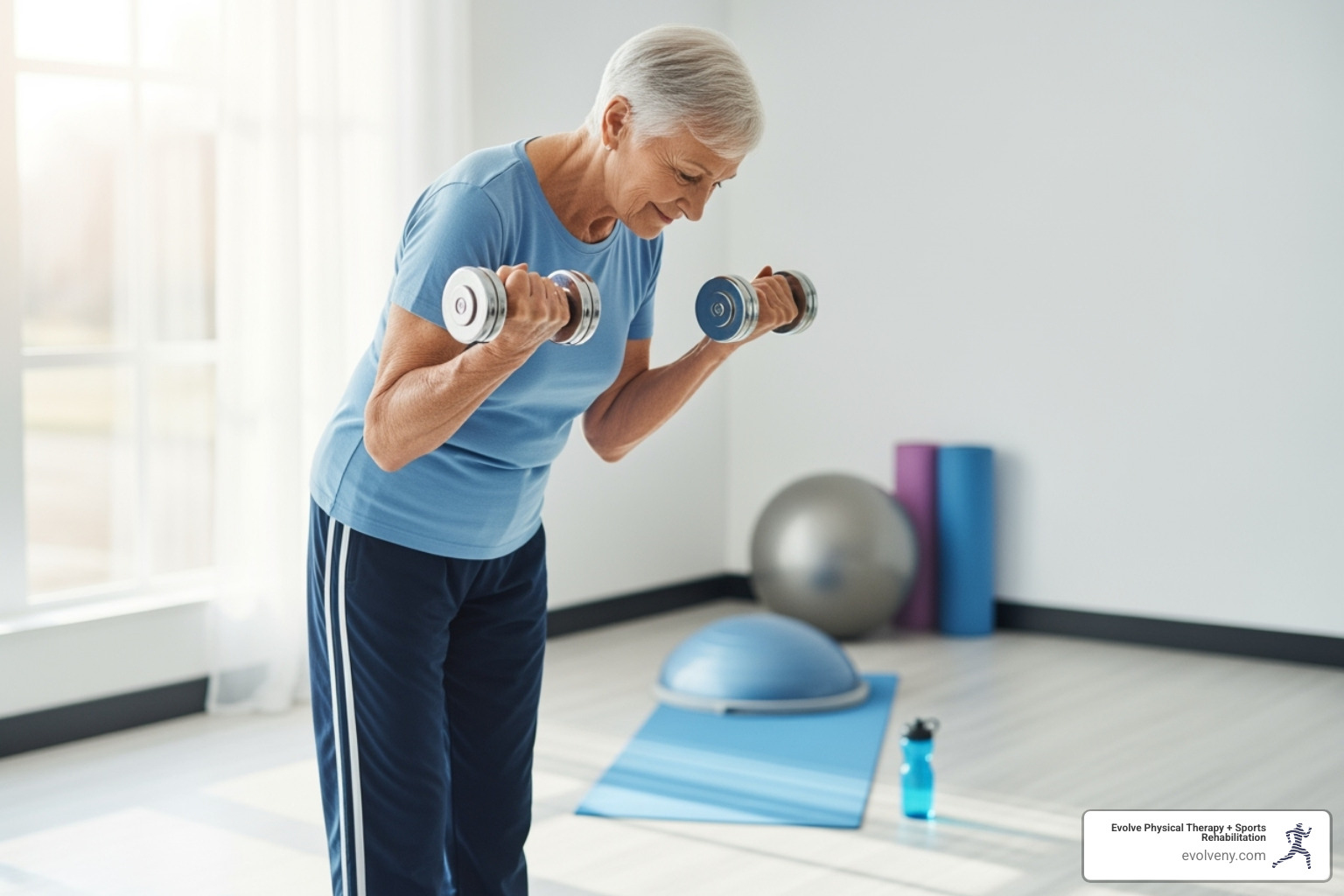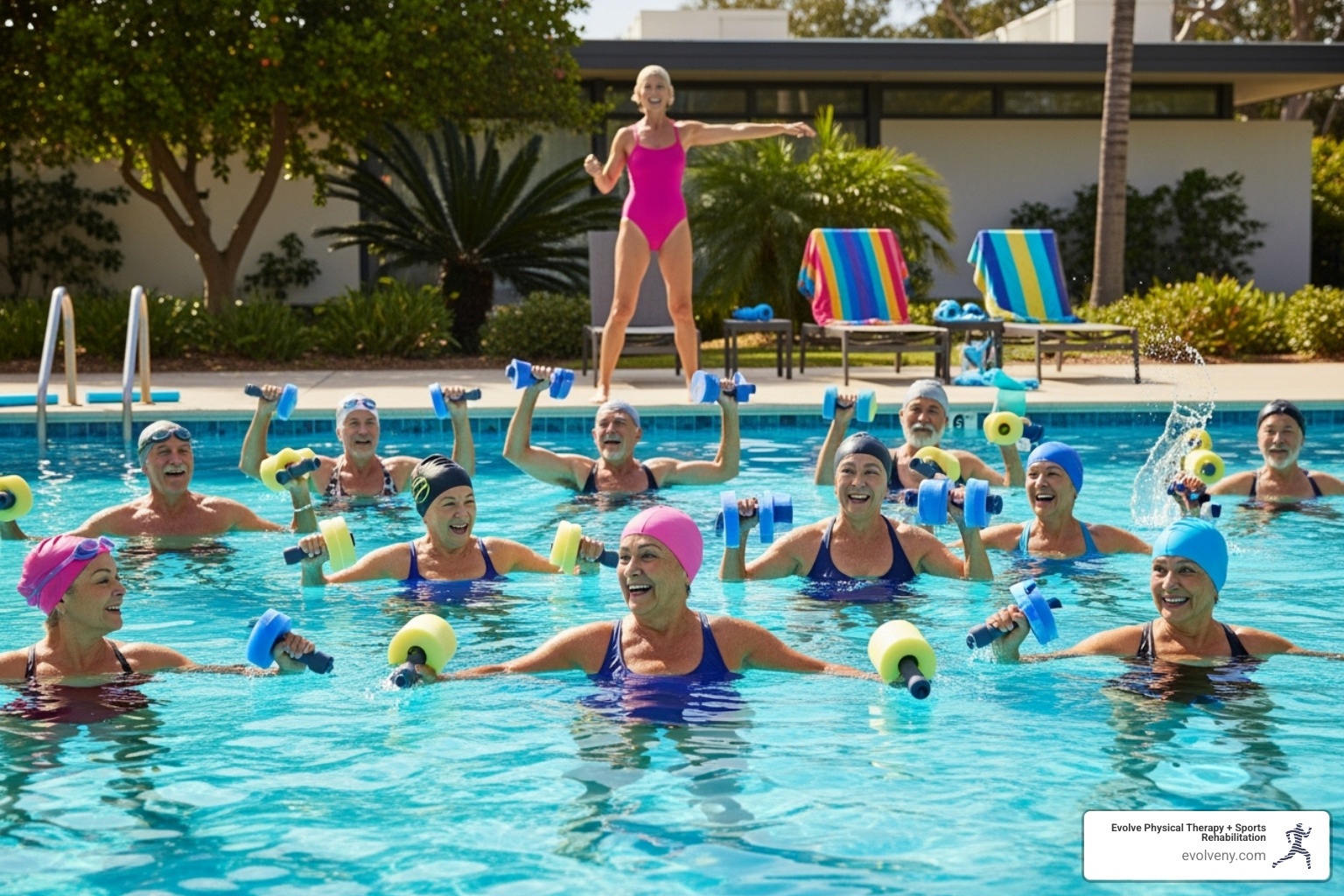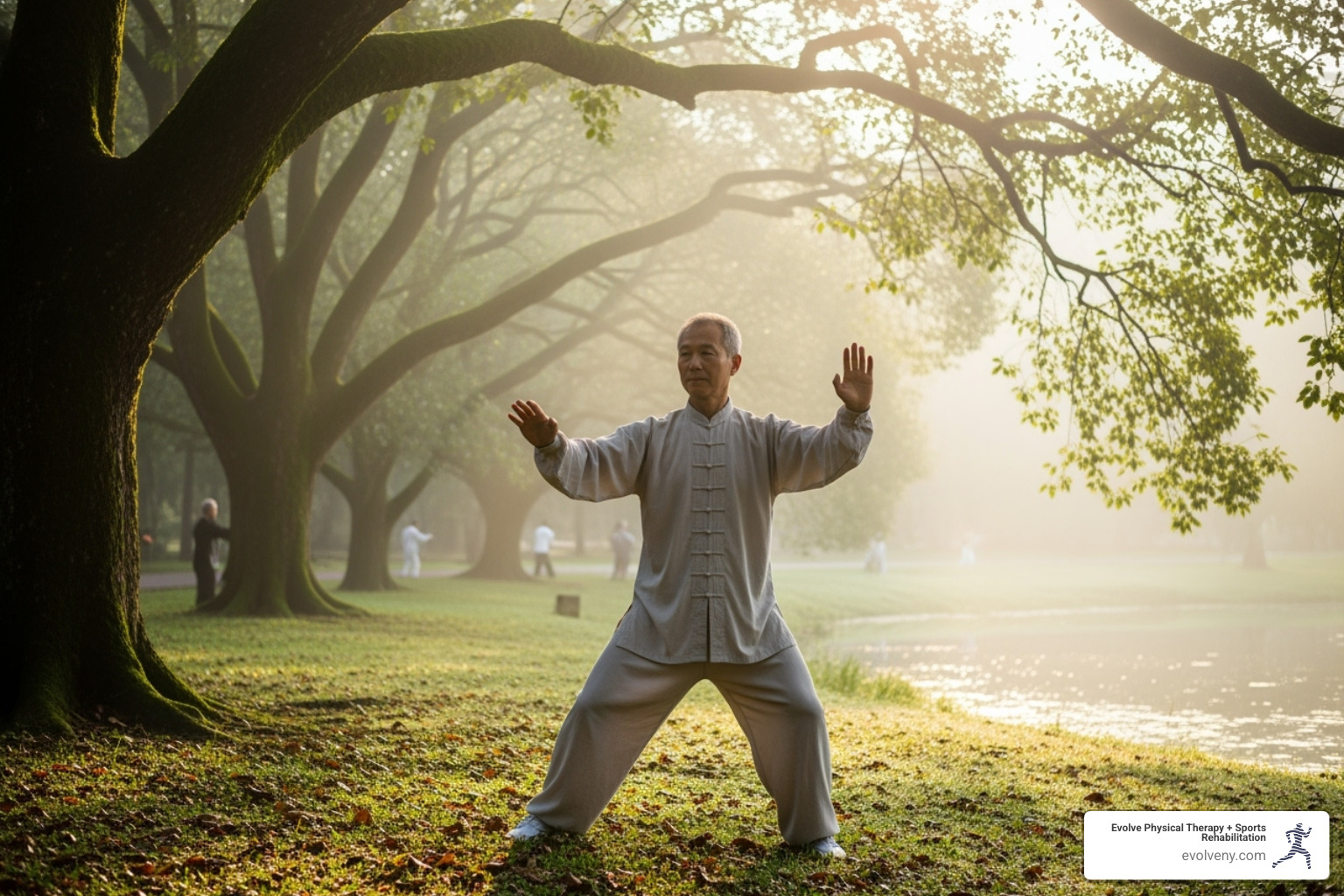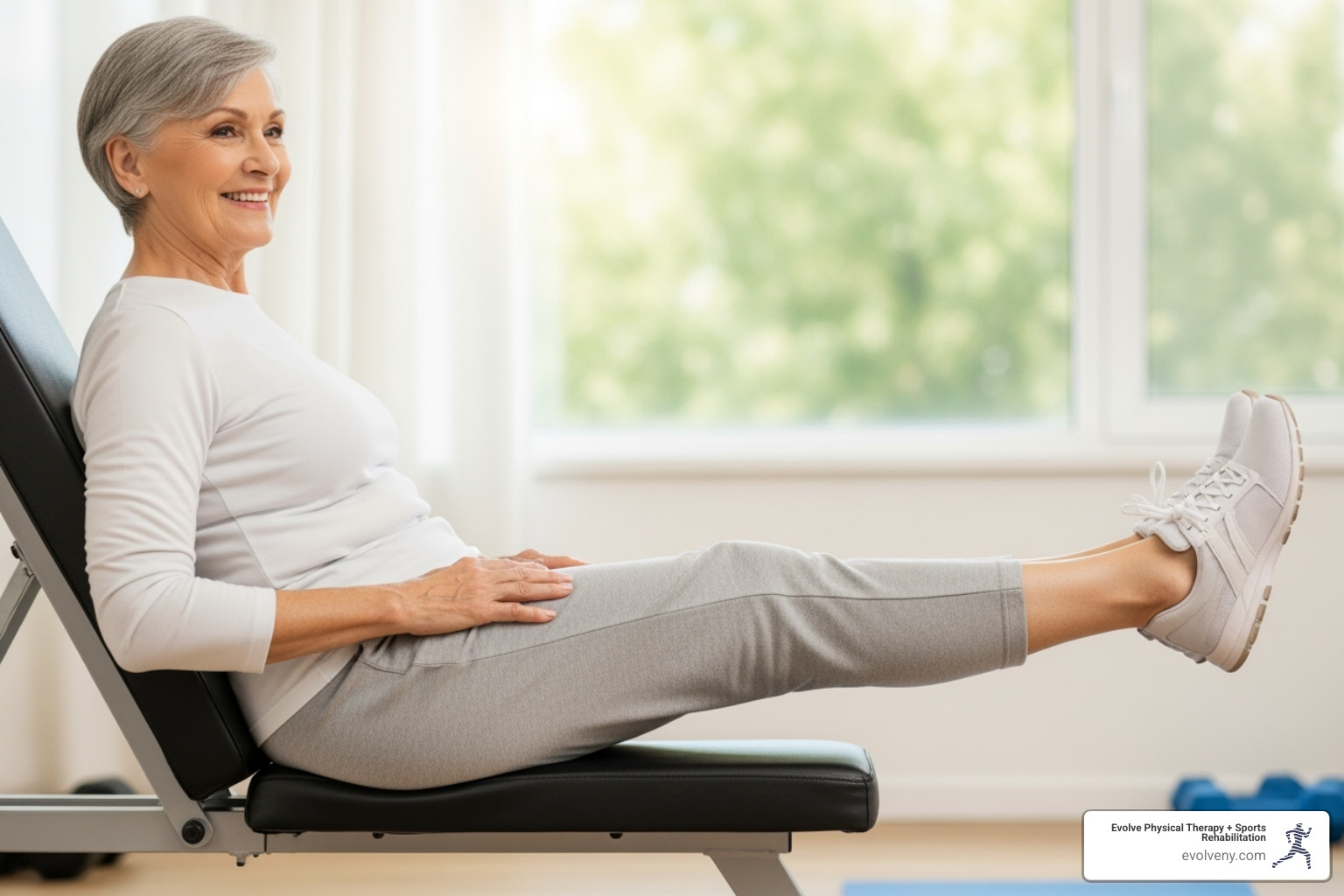Why Older Adults Should Keep Moving and Grooving
Why Movement is Medicine for Aging Adults
Exercise for older adults isn't just about staying fit - it's about maintaining independence, preventing disease, and adding quality years to your life. The research is crystal clear: regular physical activity can reduce your risk of falls by up to 50%, help manage chronic conditions like arthritis and diabetes, and keep your mind sharp as you age.
Here's what older adults need each week according to the CDC:
- 150 minutes of moderate-intensity aerobic activity (like brisk walking)
- 75 minutes of vigorous-intensity activity (or a combination of both)
- 2+ days of muscle-strengthening activities
- Balance exercises to prevent falls
- Daily movement - even light activity counts
The four key types of exercise work together like a powerful health formula:
- Endurance (Aerobic) - strengthens your heart and lungs
- Strength Training - maintains muscle mass and bone density
- Balance - prevents dangerous falls
- Flexibility - keeps you mobile and reduces stiffness
Yet less than one-third of Americans aged 65+ meet these basic recommendations. That's a missed opportunity for healthier aging.
I'm Lou Ezrick, a physical therapist with nearly two decades of experience helping people overcome chronic pain and movement limitations. Throughout my career, I've seen how proper exercise for older adults can transform lives - from helping seniors regain strength after injury to preventing falls that could end independence.
The "Why": Unpacking the Health Benefits of Regular Exercise
Think of exercise for older adults as a daily dose of medicine that feels good to take. The science is overwhelming: staying active protects our independence and quality of life. As the National Institutes of Health notes, many types of exercise can lengthen older adults' lives. Even moderate activity can prevent health problems, strengthen muscles, and keep your brain sharp. The physical benefits are just the beginning; regular movement also boosts mental wellness, helps manage chronic disease, and dramatically reduces fall risk.
Boost Your Physical Health
Your body is adaptable at any age. Give it the right movement, and it will respond with strength and resilience.
- Heart Health: Regular activity strengthens your heart, improves circulation, and helps with stroke prevention by keeping blood pressure in check.
- Bone Density: Weight-bearing activities and strength training increase bone density, which is crucial for preventing fractures. For those with osteoarthritis, targeted exercises can reduce pain and improve function, an area where specialized care like Physical Therapy for Osteoarthritis Brooklyn is invaluable.
- Improved Mobility: Exercise keeps joints and muscles flexible, making daily activities like reaching, bending, and walking easier. If you're limited by muscle weakness, it's often reversible with a targeted approach through Physical Therapy for Muscle Weakness.
Sharpen Your Mind and Mood
Exercise is one of the best things you can do for your brain, answering the question "Working Out to Stay Sharp: Can Exercise Keep Your Brain Healthier?" with a resounding yes.
- Cognitive Function: Physical activity increases blood flow to the brain, which helps maintain sharp thinking and may reduce the risk of dementia.
- Mood and Sleep: Exercise releases endorphins that fight depression and anxiety. It also leads to improved sleep and serves as excellent stress relief.
- Fall Prevention: Falls are a serious concern, but the right exercise program can dramatically reduce your risk. Our specialized Physical Therapy for Fall Prevention builds the strength and confidence you need to stay active and independent.
The "What": The Four Pillars of Exercise for Older Adults
Now that we know why exercise for older adults is vital, let's cover what to do. A complete fitness plan has four pillars: endurance, strength, balance, and flexibility. The CDC recommends adults 65+ get 150 minutes of moderate-intensity aerobic activity or 75 minutes of vigorous activity weekly, plus muscle-strengthening activities at least twice a week.

Some activity is always better than none. Every step counts. For comprehensive details, see the Physical Activity Guidelines for Americans, 2nd edition. If stability is a concern, our Balance and Gait Training program can help.
Endurance (Aerobic) Exercise for a Healthy Heart
Aerobic exercise strengthens your heart and lungs. You're at the right intensity if you can talk but not sing—the "talk test."

Great options include brisk walking, swimming, water aerobics, cycling, dancing, pickleball, and even vigorous gardening or housework. Activities like swimming are especially gentle on the joints.
Strength Training: The Key to Independence
Strength training reverses age-related muscle loss, which is essential for independence. Strong muscles protect joints, boost metabolism, and maintain bone density. The CDC's guide, "Growing Stronger: Strength Training for Older Adults," highlights how even small gains make a big difference.

You can build strength at home using light weights, resistance bands, or bodyweight exercises like chair squats and wall push-ups. Even carrying groceries counts. Aim for two sessions a week, working muscles until they feel challenged.
Balance Exercises: Your Best Defense Against Falls
Balance exercises can reduce your fall risk by up to 50%. They train your vision, inner ear, and body sensors to work together, making you steadier on your feet.

Simple yet effective exercises include standing on one foot (holding a chair for support) and heel-to-toe walking. Tai Chi is especially beneficial, as it combines gentle movements with deep breathing to improve balance, flexibility, and strength. The National Center for Complementary and Integrative Health explains the benefits of Tai chi in detail. For targeted help, consider our Elderly Balance Training or Physical Therapy for Balance Disorders in Brooklyn.
Flexibility and Mobility: The Importance of exercise for older adults
Flexibility training keeps you limber and reduces stiffness, making daily tasks like reaching, bending, and looking over your shoulder easier. Stretch when your muscles are warm, such as after a workout or shower.
Good stretches include shoulder rolls, neck stretches, and a seated hamstring stretch. The National Institute on Aging's YouTube channel offers excellent stretching videos for older adults. If posture is affecting your mobility, our Physical Therapy for Posture Training can help. Hold each stretch for 15-30 seconds without pushing into pain.
Getting Started Safely and Sticking With It
Starting a new fitness routine requires finding a safe but challenging balance. The good news is that the benefits of physical activity far outweigh the risks for most older adults, as noted in the Physical Activity Guidelines for Americans Midcourse Report. Here’s how to begin:
- Consult your doctor: Get medical clearance before starting, especially if you have chronic conditions.
- Start slowly: Begin with 10-15 minutes of gentle activity a few times a week and build up gradually.
- Listen to your body: Pay attention to signals of fatigue or pain. Mild muscle soreness is normal; sharp pain is not.
- Warm-up and cool-down: Always prepare your body before exercise and help it recover with light stretching afterward.
- Stay hydrated: Drink water regularly, as the sense of thirst can diminish with age.
- Find an activity you enjoy: You're more likely to stick with something you find fun. Set small, achievable goals to stay motivated.
Safety First: Essential Precautions
Being smart about how you exercise is key. A few precautions can prevent setbacks.
- Proper footwear: Wear supportive, well-fitting shoes with good traction.
- Weather awareness: Avoid extreme heat or cold. Dress in layers and have an indoor backup plan.
- Pain vs. discomfort: Mild soreness is a normal part of getting stronger. Sharp, shooting, or severe pain is a signal to stop.
- When to stop exercising: Stop immediately if you feel chest pain, severe shortness of breath, dizziness, or nausea, and consult a healthcare provider.
If you're dealing with general weakness, professional guidance can provide a safe path back to activity. Our team can help with Physical Therapy for General Deconditioning in Brooklyn.
The Role of a Physical Therapist in your exercise for older adults
A physical therapist is a personal movement coach for your long-term health and independence. At Evolve Physical Therapy, we provide:
- Personalized Exercise Plans: We listen to your health history, goals, and preferences to create a program that fits your life.
- Guidance on Proper Form: We teach you to move efficiently and safely, making small adjustments that prevent injury and maximize benefits.
- Adaptations for Health Conditions: We are experts in modifying exercises for conditions like arthritis, osteoporosis, or heart disease, ensuring you can work out safely.
- Injury Rehabilitation and Prevention: We guide you through recovery and teach you how to prevent future issues.
- Confidence Building: We help you overcome fear of falling or getting hurt through gradual, supported progress, empowering you to stay active.
Our hands-on approach makes us partners in your health. Learn more about how we can support your goals with Physical Therapy for Seniors.
Modifications and Seated Exercises for Every Ability
Exercise for older adults doesn't require standing for long periods. If you have balance concerns, joint pain, or limited mobility, chair-based workouts are a comfortable and effective alternative. Seated exercises provide a stable foundation, allowing you to gain strength, improve circulation, and increase flexibility without the fear of falling.
As Harvard Health notes in its guide on "Chair exercises for seniors: Boosting strength, flexibility, and stamina," these modifications help maintain independence and well-being. All you need is a sturdy chair that won't slide.

Seated Strength and Cardio
You can build strength and get your heart pumping right from your chair.
- Chair Squats: Sit on the edge of a sturdy chair, feet flat. Slowly stand up, then lower back down until you just touch the seat. Use your hands for support if needed. This strengthens legs and improves your ability to get up from chairs.
- Seated Marching: Sit tall and lift one knee toward your chest, then alternate legs. Swing your arms naturally. This improves circulation and strengthens hip flexors.
- Bicep Curls: Using light weights or soup cans, sit with elbows at your sides. Curl the weights toward your shoulders, then lower slowly and with control.
- Seated Overhead Press: Hold weights at shoulder height and press straight up as far as is comfortable for your shoulders.
- Ankle Pumps: Flex your feet, pulling your toes toward your shins, then point them away. This helps prevent swelling and improves circulation.
Seated Stretches for Flexibility
These gentle stretches can be done anytime to improve mobility.
- Seated Hamstring Stretch: Sit on the edge of your chair and extend one leg straight, heel on the floor. Lean forward from your hips until you feel a gentle stretch. Hold for 20-30 seconds.
- Neck Rotations: Slowly turn your head to look over one shoulder, hold, then repeat on the other side. Gently tilt your ear toward your shoulder to stretch the side of your neck.
- Seated Spinal Twist: Sit tall and gently rotate your upper body to one side, using the chair for light support. Hold for 20-30 seconds, then switch sides.
- Shoulder and Chest Stretches: Roll your shoulders forward and backward. To open your chest, clasp your hands behind your back and gently straighten your arms.
Frequently Asked Questions about Senior Fitness
When it comes to exercise for older adults, many people have the same questions. Here are answers to the most common concerns we hear in our Brooklyn clinic.
How much exercise is enough for a senior?
The CDC recommends adults 65+ aim for 150 minutes of moderate aerobic activity (like brisk walking) or 75 minutes of vigorous activity weekly. Add two days of muscle-strengthening activities and regular balance exercises. You can find more details in the Physical Activity Guidelines for Americans Midcourse Report. The most important rule is that some activity is always better than none. If 150 minutes seems like too much, start with 10 minutes a day and build from there. Every step counts.
What is the single best exercise to prevent falls?
There is no single best exercise, but rather a powerful combination of balance and strength training. Balance training like standing on one foot, heel-to-toe walks, or Tai Chi is the cornerstone. Tai Chi is a gentle, flowing practice proven to reduce fall risk. Strength training, especially for the legs and core, provides the power to catch yourself if you stumble. Sit-to-stand exercises from a chair are incredibly effective for building this functional strength. Combining these approaches is the most effective strategy.
Can I still exercise with a chronic condition like arthritis?
Yes, and for many chronic conditions like arthritis, exercise is one of the best treatments. The key is to choose the right activities and modifications.
- Low-impact activities are your best friend. Water aerobics and swimming are ideal because the water supports your body weight, providing gentle resistance while soothing stiff joints.
- Chair exercises allow you to build strength and flexibility without putting stress on painful joints.
- Gentle stretching helps keep joints moving freely and prevents stiffness.
Always consult your doctor or a physical therapist before starting a new routine. We can create a personalized plan that works with your body, not against it. For those with degenerative joint disease, our specialized Physical Therapy for Degenerative Joint Disease program can help you exercise safely and effectively.
Conclusion
The message is clear: movement is medicine. Regular exercise for older adults is your key to maintaining independence, sharpening your mind, and adding vibrant, quality years to your life. From brisk walking and strength training to balance-improving Tai Chi and seated stretches, there is a safe and effective option for every ability level.
It's never too late to start, and every movement counts. Your body is resilient and will respond to consistent, thoughtful activity.
At Evolve Physical Therapy + Sports Rehabilitation, we empower our Brooklyn community—from Marine Park to Gravesend, Midwood to Park Slope, and Mill Basin—to live their best lives through movement. Our hands-on, holistic approach means we create a personalized plan to help you build strength, confidence, and resilience safely.
You don't have to start this journey alone. Expert guidance makes all the difference. Let us be your partners in health, helping you move and groove into your golden years.


